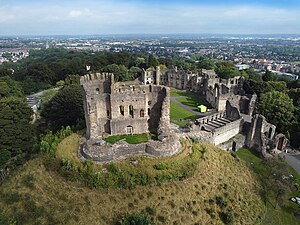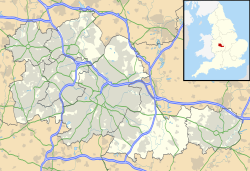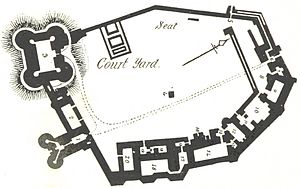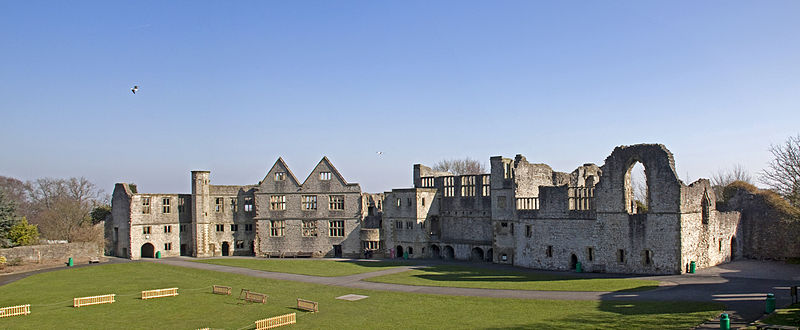
Baron Dudley is a title in the Peerage of England. It was created circa 1440 for John Sutton, a soldier who served as Lord Lieutenant of Ireland. The title descended in the Sutton family until the 17th century when Frances Sutton, the heir apparent to the title, married Humble Ward who was granted the title Baron Ward in 1644. Their heirs inherited both titles until 1740 when the differing rules of inheritance meant that the Barony of Dudley descended on Ferdinando Dudley Lea, who became the 11th Baron whilst the Barony of Ward went to John Ward, who later became 1st Viscount Dudley and Ward. On Ferdinando's death in 1757, the title fell into abeyance. The title was revived in 1916.

Earl of Dudley, of Dudley Castle in the County of Stafford, is a title that has been created twice in the Peerage of the United Kingdom, both times for members of the Ward family.

Dunster Castle is a former motte and bailey castle, now a country house, in the village of Dunster, Somerset, England. The castle lies on the top of a steep hill called the Tor, and has been fortified since the late Anglo-Saxon period. After the Norman conquest of England in the 11th century, William de Mohun constructed a timber castle on the site as part of the pacification of Somerset. A stone shell keep was built on the motte by the start of the 12th century, and the castle survived a siege during the early years of the Anarchy. At the end of the 14th century the de Mohuns sold the castle to the Luttrell family, who continued to occupy the property until the late 20th century.
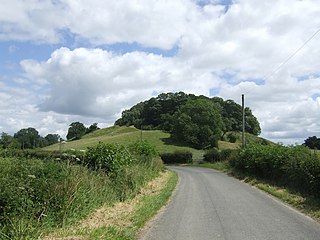
Caus Castle is a ruin of a hill fort and medieval castle in the civil parish of Westbury in the English county of Shropshire. It is situated up on the eastern foothills of the Long Mountain guarding the route from Shrewsbury, Shropshire to Montgomery, Powys, on the border between England and Wales. It was destroyed during the English Civil War and has been in ruins since.

Clare Castle is a high-mounted ruinous medieval castle in the parish and former manor of Clare in Suffolk, England, anciently the caput of a feudal barony. It was built shortly after the Norman Conquest of England in 1066 by Richard Fitz Gilbert, having high motte and bailey and later improved in stone. In the 14th century it was the seat of Elizabeth de Clare, one of the wealthiest women in England, who maintained a substantial household there. The castle passed into the hands of the Crown and by 1600 was disused. The ruins are an unusually tall earthen motte surmounted by tall remnants of a wall and of the round tower, with large grassland or near-rubble gaps on several of their sides. It was damaged by an alternate line of the Great Eastern Railway in 1867, the rails of which have been removed.
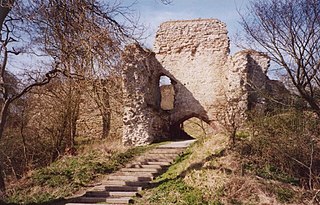
Wigmore Castle is a ruined castle about 1 km (0.62 mi) from the village of Wigmore in the northwest region of Herefordshire, England.

Hertford Castle was built in Norman times beside the River Lea in Hertford, the county town of Hertfordshire, England. Most of the internal buildings of the castle have been demolished. The main surviving section is the Tudor gatehouse, which is a Grade I listed building. Parts of the bailey walls on the east side of the castle also still stand, and are a Grade II* listed building.

Bramber Castle is a Norman motte-and-bailey castle, formerly the caput of the large feudal barony of Bramber long held by the Braose family. It is situated in the village of Bramber, West Sussex, near the town of Steyning, overlooking the River Adur.

Clifford Castle is a ruined castle in the village of Clifford which lies 2.5 miles to the north-east of Hay-on-Wye in the Wye Valley in Herefordshire, England. It was the caput of the feudal barony of Clifford, a Marcher Lordship. The castle stands in the grounds of a private house and is only open to the public on certain days of the year.

Gloucester Castle was a Norman-era royal castle situated in the city of Gloucester in Gloucestershire, England. It was demolished in 1787 and replaced by Gloucester Prison.
Swindon is a village and civil parish located in the West Midlands. The nearest towns are Dudley and Stourbridge. It lies halfway between the town of Kingswinford and village of Wombourne.
Stockport Castle was a promontory castle in Stockport, Greater Manchester, England. The castle was in the medieval town, overlooking a ford over the River Mersey. It was first documented in 1173, but the next mention of it is in 1535 when it was in ruins. What remained of the castle was demolished in 1775.

Dudley Priory is a dissolved priory in Dudley, West Midlands, England. The ruins of the priory are located within Priory Park, alongside the Priory Estate, and is both a scheduled monument and Grade I listed. The ruins received this status on 14 September 1949.

The de Birmingham family held the lordship of the manor of Birmingham in England for four hundred years and managed its growth from a small village into a thriving market town. They also assisted in the invasion of Ireland and were rewarded with the Barony of Athenry. They were stripped of most of their lands in England by the notorious John Dudley, Duke of Northumberland, who held sway over the young King Edward VI (1547–1553).
Ansculf de Picquigny was a French baron who followed William the Conqueror to England.
William Fitz-Ansculf was a Norman-French landowner who succeeded his father, Ansculf de Picquigny.
Sir John de Sutton II was the first Baron Sutton of Dudley, who was summoned to the Parliament of England in 1342. He was the son of John de Sutton who inherited Dudley Castle by marriage to Margaret, daughter of Roger de Somery. John II married Isabella, daughter of John Charleton, 1st Baron Cherleton of Powys, before 1329. He was succeeded by his only son Sir John de Sutton III (1338-1370), 2nd Baron Sutton of Dudley. Upon the death of John II, possession of the Castle Dudley was vested to his wife Isabella from 1359 to 1397.
Gervase Paganell inherited the feudal barony of Dudley around the year 1150. However, after rebelling against King Henry II, his castle was demolished. Gervase founded the Cluniac Priory of St James in Dudley and probably founded the Church of St Thomas in Dudley. He died in 1194.
Ralph de Somery I inherited the barony of Dudley on the death of his uncle, Gervase Paganell, in 1194 although he did not get full ownership of the lands until the death of his mother in 1208. Ralph swapped land that he owned at Wolverhampton with King John, obtaining estates at Kingswinford which proved very valuable to later Lords of Dudley during the Industrial Age. He had three sons and died in 1210.
Roger de Somery inherited the feudal barony of Dudley in 1235. In 1262, Roger started the re-fortification of Dudley Castle, which had been slighted by order of King Henry II after a rebellion in 1173-1174. Roger married twice and died in 1272.
